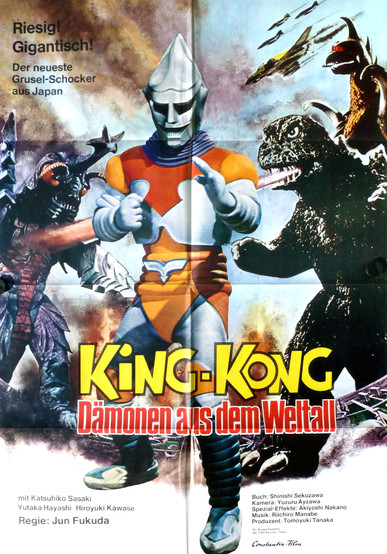"Godzilla V Megalon", Dir: Jun Fukuda, 1973
- Ravi Swami
- Jun 18, 2021
- 7 min read
Criterion Channel includes a number of Godzilla / Giant Monster - or "Kaiju" - films, along with documentary extras and I've been going through them slowly as the mood takes me - which isn't often since I tend to view them as a treat when I need some simple entertainment.
Firstly, apologies to any hard-core "G-Fans" out there but it's rare for me to watch *any* Godzilla film without dozing off somewhere down the line for reasons described below, consequently there are often chunks that I miss, the upside of this being that each time I watch one it's like discovering it - almost but not quite - for the first time, as if it is the product of some kind of fever dream.
I have actually seen "Godzilla V Megalon" before on terrestrial TV in the U.K and my main memory of it centers on the inclusion of a new character to the Godzilla universe: "Jet Jaguar", a super-robot that curiously only ever made this one appearance.
By the mid 1970's, Godzilla had moved on from the lumbering King-Kong inspired giant marauding monster - a film that coincidentally I have just watched on a terrestrial broadcast before writing this post - into something that would be more appealing to younger audiences in being essentially benign and friendly. This is also reflected in his ever-changing design, here with more cartoony proportions of a larger head, big expressive eyes and a goofy performance driven by the performer wearing the trademark foam rubber suit of the Japanese Toho studios.
Ishiro Honda, who directed the first ever Godzilla film and some later additions to the genre, had moved on by 1973 and the directorial reins for this film were taken over by Jun Fukuda, who was responsible for injecting an element of whimsy in the plots in a series of these films.
Aside from the giant monster fights, the main appeal of these films for me are the ideas contained within them that very often reflect the obsessions of the era in which they were made. By "Godzilla V Megalon" popular culture had moved away from the fear of atomic war that is at the root of the very first film, to other topics such as U.F.O's and fringe ideas like lost civilizations that have their basis in the works of the Theosophists, Edgar Cayce and Orientalist speculations dating back to the late 19th Century.
My memory of the period is of Erich Von Daniken's "factual" books on supposed extraterrestrial intervention in Earth's distant past and "Godzilla V Megalon" is awash with many such ideas, which are tossed about by characters in the film in a very matter-of-fact way.
When nuclear tests cause earthquakes and a crack in the Earth unleashes a gigantic mutant stag beetle - the "Megalon" of the title - the remnants of the "Mu" and "Lemurian" civilisations who have built an undersea kingdom called "Seatopia" following their destruction in the distant past, are seen to be responsible.
Here, mankind's scientific advances and disregard for the environment (the other obsessions of the period, especially in regard to Japan) pose a threat to the more technologically advanced Seatopian's existence and they unleash "Megalon" to teach us a lesson by, curiously, trying to flatten Tokyo yet again.
Two Seatopian agents are dispatched to the surface world and zero-in on a young Frankenstein-like scientist working from a secret lab in his house who has built a super-robot called "Jet Jaguar". They break into the lab and take control of the robot and use it to direct Megalon toward Tokyo.
Into the mix Fukuda, who wrote the script, includes "Rokuro", the scientists' younger brother, a baseball-cap wearing pre-teen, following a trend that characterized many of the late 1960's and 70's Godzilla films of appealing to a very young audience, Rokuro's main role is to cheer on Godzilla and to get into various scrapes.
The film includes a de-rigeur for the 70's mad-cap car chase as Seatopians try to stop the scientist's friend, "Hiroshi Jinkawa" from rescuing "Goro Ibuki", the scientist, and "Rokuro", who have been tied up and put into a cargo container on a lorry by the Seatopian agents with the intention of dumping them into a dam.
To up the ante, the Seatopians also call upon "Gigan", another giant Kaiju that featured in other Godzilla films, to help Megalon defeat Godzilla, who has been roused from his home on "Monster Island", (along with other Kaiju seen in previous and later films), following earthquakes caused by the nuclear tests.
This sets the stage for the main draw of these films, the titanic face-offs between giant monsters, and it's these sections that actually send me to sleep for some reason. It may be the music or the style of editing or the fact that they can seem interminable but I have no doubt that they are more compelling in the environment of a cinema, with a large screen that fills your field of view - on TV they seem to interrupt the narrative flow, wacky as it often is with these films.
The extras included for the film reveal that the film was made over what seems like a ridiculously short space of time of two weeks but this is never evident in the film. In common with a lot of the Godzilla films there is much re-use of stock shots from previous films, of explosive destruction of miniature cities, military vehicles rolling up to deploy barrages of missiles, and people running for cover. The miniature work however is top-class, especially evident in new sequences shot for the film.
When the lorry with the cargo container containing Goro and Rokuro reaches the dam and is about to dump it, Megalon arrives and trashes the dam, which causes cascades of water to crash down and destroy the dam walls and eventually Megalon itself crashes through it and is swept along by chunks of debris and tons of earth.
These sequences are quite astonishing to watch even if you know that Megalon is essentially a man in a rubber suit, as miniature vehicles get swept away in a torrent and tons of debris are dumped on Megalon, something that must have been very difficult for the performer sewn into the foam-rubber and latex suit and that reminds you that the level of such risk has been pretty much eliminated in contemporary films through the use of CGI, and which lessens their impact as result.
Watching Megalon bounce along in a huge, panoramic, beautifully detailed miniature landscape reminds you that off-screen crew were hoisting up hundreds of pounds of weight of human performer and foam rubber and latex costume on piano wires, a feat that still seems incredible to me even now.
It's this "realism" that makes these films compelling to watch if you can look past the absurdities of the plots and random changes of scale and add a surreal dreamlike quality to the films that echo the quality of the film that kicked off the whole giant monster genre, King Kong.
There is another element at work in these films which is a reflection of the Japanese interest in the micro and macrocosmos - humans are reduced to insect-like insignificance as the monsters slug it out and I'm reminded of recent gardening experiences of zapping blackfly and ants on fruit trees with a garden hose, the giant Kaiju conduct their business in the same way, though the lesson for the audience is that, like Godzilla, we must show some regard for the patterns of nature - days later, the blackfly and ants return to continue what they do regardless of my efforts to bring order to the garden.
The inclusion of "Jet Jaguar" was apparently to cash in on the period's obsession for giant robots inspired by characters that appeared first in Japanese Manga comics, like "Gigantor" etc - when Jet Jaguar first appears, he is human-scaled but becomes "Kaiju" sized when he is required to take on Megalon, supposedly because of Seatopian interference though the explanations given are typically foggy :)
Not quite evolved into the "transforming" robots of later films, Jet Jaguar, being a man in a rubber suit, is still a fascinating addition to the genre that may be a nod in the direction the hugely popular Toho "Ultraman" - a creation of Eiji Tsuburaya, who masterminded the visual effects for the first, and later, Godzilla films.
There are some curious aspects to the film that seem at odds with the fact that it was aimed at a broader audience. For example, scenes shot of the cab of the lorry carrying the cargo container show naked Playboy pinups on the back wall of the cab in clear view and on several occasions and their inclusion may reflect either more liberal attitudes in Japan or a way of appealing to adult male audiences - whatever the reason, they are somewhat distracting and it's possible that these scenes were edited out for overseas or TV audiences with the inevitable consequence of odd jumps in the narrative.
To Criterion's credit they strive to present films as much as possible as originally intended and in their original language with subtitles, which to me, is always preferable.
The themes explored in the film began to wane by the late 70's and 80's and disappeared pretty much until the internet opened up interest in fringe ideas again in the late 90's and can be seen in the most recent Godzilla films emerging from America, with their plots featuring supposed lost civilizations and the "Inner Earth" etc, though devoid of a lot of the charm of their predecessors.
The film ends with Godzilla triumphing over both Megalon and Gigan - of course :) - and Jet Jaguar is restored to being a "mindless robot", having experienced a brief moment of sentience thanks to the Seatopians - a plot inclusion intended to draw in speculations about sentient machines, another obsession of the era that anticipates contemporary concerns.
The closing shots are of Rokuro riding piggy-back on Jet Jaguar with his brother Goro and Hiroshi to a jaunty "Jet Jaguar March", perhaps toward new adventures that never actually came to be, and as such, Jet Jaguar remains a singular and novel presence in the Godzilla films cycle.
"Godzilla V Megalon", Dir: Jun Fukuda, 1973
Available to view online on Criterion Channel.











Comments